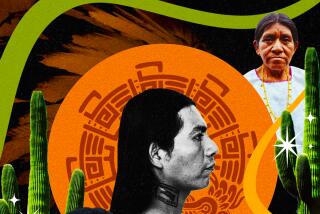Rincon Scholar : Storekeeper Quietly Recorded Luiseno Language, Culture
- Share via
In bold headlines the San Diego newspapers of May 21, 1907, announced a shocking crime: the murder of Philip Stedman Sparkman, a storekeeper in the small community of Rincon, at the foot of Palomar Mountain.
Sparkman was a popular man and known throughout San Diego County. But to most of his friends and acquaintances, Sparkman was an enigma. Only in death did San Diego learn that the quiet bachelor, “the Englishman at Rincon,” was actually an accomplished scholar who would leave important academic contributions to this region.
Sparkman came to America at 19, sailing from Liverpool with 50 in his pocket. Slowly making his way West, he found work in railroad yards in Albuquerque, New Mexico. He decided the way to get ahead in the West was to become a merchant, and in 1880, he opened a store in Albuquerque. More moves followed. After several short-lived store ventures in rough towns along the Santa Fe Trail, Sparkman decided to go to California, “resolving never to go into business in a town again.”
Rincon, with a small population of ranchers and Indians, was what Sparkman had waited for. For the next 18 years he prospered in the quiet, rural community. His well-stocked store and honest business habits made him a respected member of his community. A friend noted that Sparkman lived simply in an adobe house only 30 yards from his store. He was “very neat and methodical, quiet, studious . . . even tempered . . . temperate in his habits, not even using tobacco.”
A neighbor, rancher Louis Salmons, recalled:
“This Sparkman was an Englishman. When you’ve said that you’ve said a lot. He was a very peculiar man. You’d walk in the store, and he’d stand there with his hand on the counter and wait for you to pick out something. He was a fine man. I knew him better than anyone around here.”
To Salmons and other friends who thought they knew him, Philip Sparkman was simply a country storekeeper, albeit a strangely bookish storekeeper with an intense curiosity in the local Indians, the Luisenos.
Sparkman found the Indians fascinating. Before coming to San Diego County, the merchant had taught himself Spanish while living in New Mexico. Now, he decided to learn the Luiseno language and culture. It began as a hobby, soon it became an obsession.
He built two rooms behind his store: a spare bedroom, and a study where he could retreat in leisure moments to “puzzle out the idioms and construction of the language.” He hired an Indian boy named Gomez to come to the store in the evenings to teach him the tongue, word for word. The old men of the tribe provided more words and meanings, and told Sparkman of their ancient customs and rituals.
For years, Sparkman spent every spare moment recording all facets of the Luiseno culture--their folklore, customs, religion, and, most importantly, their complex language. Eventually, he mastered the difficult vocabulary, and for the first time, the previously unwritten Luiseno speech was recorded in text. A neatly typed manuscript was bound into volumes.
Late Sunday night, May 19, Sparkman was shot and killed in the yard in front of his store. His body was found early the next morning. Although a light still burned brightly in the store, nothing was missing. The authorities surmised that Sparkman had been lured from his house late at night, probably by someone he knew. There had been no robbery, no explanation for the murder. He was 50 years old.
The newspapers quickly blamed Indians for the crime, but no arrests were made. It would have been ironic, and certainly unlikely, for Sparkman to have been killed by an Indian. A coroner’s jury closed the case after a few days, ruling that Sparkman had died from wounds inflicted by parties unknown.
One week after the murder, Edward H. Davis, a friend of Sparkman’s from Mesa Grande, revealed in the San Diego Union the story of the storekeeper’s work recording the language and customs of the Luiseno Indians. “His monumental work on their language,” wrote Davis, “is of the highest and most scientific order of any that has ever been written in this country.”
The next year, Sparkman’s “Culture of the Luiseno Indians” was published by the University of California. His “Grammar and Dictionary of the Luiseno Language” also was published. Both classics of anthropology, the remarkable works of the modest English storekeeper are respected to this day.
More to Read
Sign up for Essential California
The most important California stories and recommendations in your inbox every morning.
You may occasionally receive promotional content from the Los Angeles Times.













